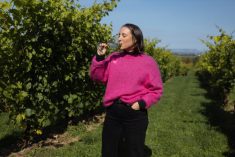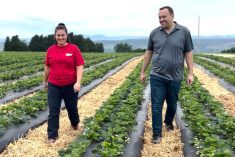They were two non-farmers who started out with $500, a wheelbarrow and a dream. Less than 10 years later, Francois Handfield and Veronique Bouchard have a thriving organic market garden, community shared agriculture business supplying produce to about 4,000 people, they employ up to 20 seasonal workers, and gross about $800,000 annually.
A lot of work, yes, but it underscores the idiom “where there is a will there is a way.” Hard work and good management skills will bear fruit.
It was their hard work, agronomic skills and keen interest in business management that earned Handfield and Bouchard the nod as Quebec’s Outstanding Young Farmers (OYF) for 2017. They are among the seven regional finalists who will compete for Canadian OYF honours at the national awards event in Penticton in late November.
Read Also

Claas brings 1000 Series SP forage harvesters to Canada
In mid-August, Claas unveiled its new line of Jaguar forage harvesters at an event in Visalia, California, deep in the heart of that state’s dairy region.
Handfield and Bouchard established their 11-acre farming operation near Mont Tremblay in the Laurentian Mountains of western Quebec. They are about 1.5 hours north or east of Montreal and Ottawa, respectively.
“It is a fairly rugged, cooler region of Quebec that doesn’t have much agriculture,” says Handfield. “But we found a suitable location.” He was born in the Mont Tremblay area, although his parents didn’t farm.
Interestingly, they both started university with plans to study music, but partway through their schooling switched over to agriculture. Handfield had worked some agricultural internships before university. While the couple love music, they both had a passion and interest to produce high quality and healthy farm products in a very sustainable system.
“What we liked about organic agriculture production was that it involved producing high quality food in an environmentally sound system where we had to work co-operatively with nature,” says Handfield.
At university, Handfield studied agriculture engineering, while Bouchard took agronomy. They eased into vegetable production in 2005 while still in school and went full time farming in 2008. “All we had was $500 for seed, a wheelbarrow and a shovel and a plan,” says Handfield. “We started everything from scratch.”
Today they grow about 65 different vegetables on their 11-acre farm. As well as they have a 20,000 square foot greenhouse. Part of that is used for propagation to produce bedding plants for their own use, as well as retail sales to customers. About three-quarters of the greenhouse area is used to produce a range of greenhouse crops such as tomatoes, cucumbers, eggplant and others, which helps to extend both ends of the growing season. Along with their seasonal field operations, they can produce some products early in the spring and continue late in the season to meet customer demand.
At their farm, Ferme Aux Petis Oignons, they have developed a diversified marketing program. About 45 per cent of their business is Community Shared Agriculture (CSA) where they put together weekly baskets of fresh produce to be used by about 600 subscribing customers. Customers pick up their baskets at one of three delivery points. Another 20 per cent of their produce is marketed through three major farmers markets and 10 per cent is sold through a self-serve, honour-system of farm gate sales. They also sell some produce to local retailers as well.
About 40,000 people live in the larger trading area around their Mont Tremblay farm, says Handfield. “We estimate between the CSA baskets and the farmers’ markets we are supplying fresh produce to about 10 per cent of the people in the region. And of course we are always interested in attracting new customers to high quality, organically produced foods.”
While learning the agronomics of organic vegetable production is one part of the story, Handfield and Bouchard also found they had talent for the entrepreneurial side — learning how to market, developing the human resource skills to work with employees and of course business management. They have six full time employees with as many as 20 seasonal workers.
And along with farm production and management skills, training as an agricultural engineer also came in handy. Handfield discovered there wasn’t a lot of available (and sometimes) affordable field equipment for their 11-acre farm, so he has spent many hours in the shop building his own machinery for field operations. The shop is an interesting arrangement, too. He is part of a co-operative with 10 other area farms that have access to one well-equipped machinery shop for fabricating and maintenance work.
While there are “always 1,000 projects” to work on, Handfield says they continue to improve crop production techniques — new equipment for in-row tillage, netting for crop rows to minimize pest damage, and green manure to improve soil fertility. He is also developing a renewable energy source to improve efficiency of greenhouse operation. That involves a biomass furnace that will burn hardwood pellets and help reduce their energy costs by half.
















